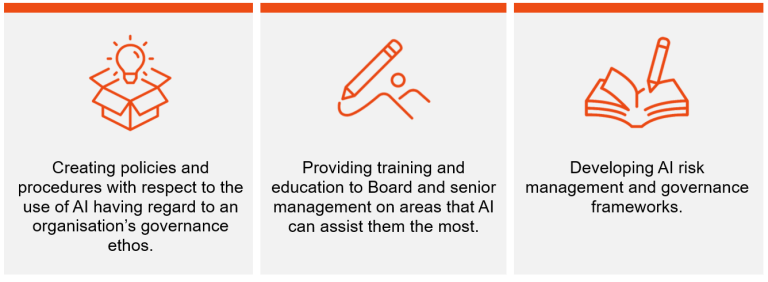
Introduction
In this paper, we take the opportunity to delve into how we can manage the usage of artificial intelligence (AI) across the financial sectors.
When AI and governance are mentioned together, there can often be confusion about whether we are discussing the use of AI for governance tasks or how we govern AI when it’s used for investment purposes. This paper has a singular focus on the latter – how asset owners can govern the use of AI in their processes.
AI is rapidly being deployed across many commercial, technology and educational sectors due to its perceived benefits, including operational improvement and competitive advantage. By incorporating AI into key activities such as investment decision-making and data analysis, institutions can maximise benefits and enhance productivity. However, rapid adoption of AI, without appropriate checks and balances poses significant risks akin to trusting a computer to complete your homework by itself without relying on human inputs or review.
It is important for all institutions to find the right balance on leveraging AI in investment decision-making and eliciting benefits balanced with the appropriate governance controls for its use. This is crucial for all asset owners and serves as the focus of our paper, which we believe may be the first in a series on investment governance AI (or IGAI) in the coming years.
Our detailed paper examines how AI is currently used in organisations; current developments and associated risks; investment governance of AI in Australia and other regions; and what it means for asset owners.
We also explore how clients can manage the key risks arising from misapplication of AI such as:
- Adoption of AI generated policies and procedures without sufficient testing and verification processes.
- Acceptance of governance AI outputs without consideration for the organisation’s values and stakeholders.
- Lack of AI crisis management arising internal or external sources.
Frontier can provide guidance on managing the implementation of AI for investment decisions within an organisation by:

The final word
The implementation of AI in investments is not without significant risks and costs if not done properly. Considering the investment governance regulatory landscape and the application of established principles during AI implementation can help organisations mitigate potential risks.
The landscape is constantly changing from region to region, with AI being implemented across all aspects of businesses at an unprecedented rate. The highly disruptive nature of AI, as well as APRA comments in recent times, highlight the need for a solid governance ecosystem. This helps ensure it can be deployed in a beneficial and responsible manner.
Through good governance principles asset owners can derive benefits and mitigate risks. The benefits can include:
- Increasing efficiency
- Enhancing processes
- Achieving big results with reasonable budgets

All of this can lift the governance capacity if done well. Please see the Frontier/KPMG paper on governance to understand more.
If you want to discuss this paper in more detail or learn more about how we can help, please get in touch with our Investment Governance Team or your consultant.


